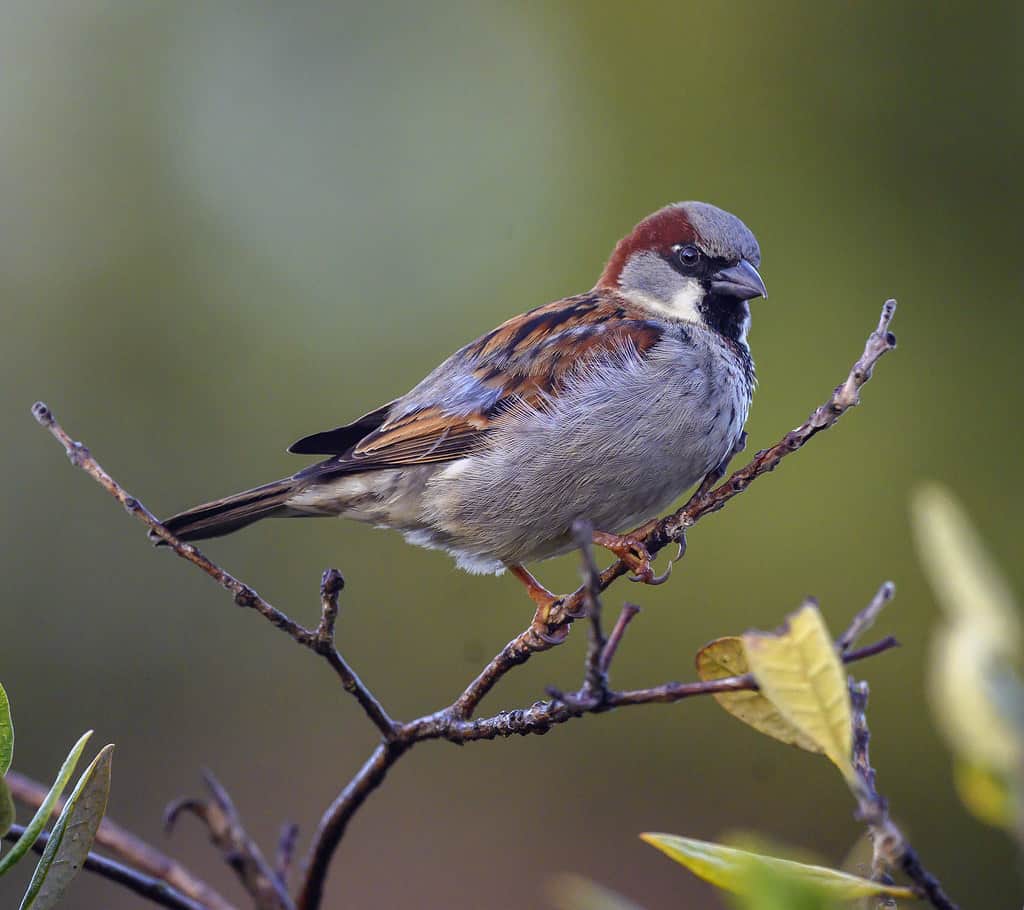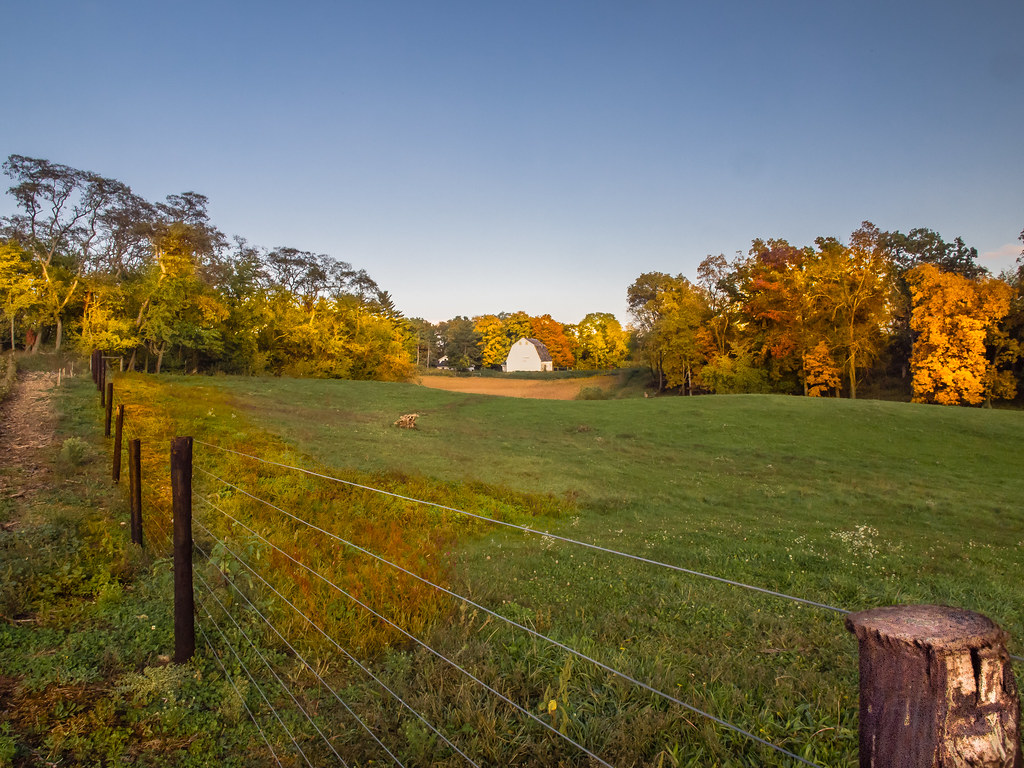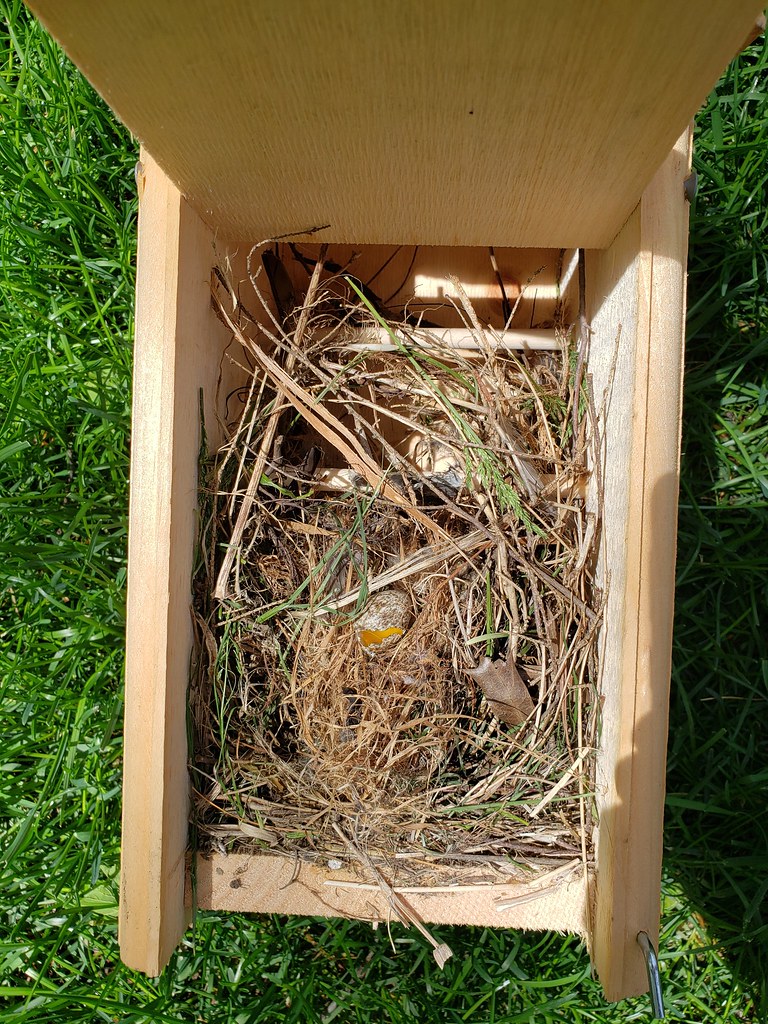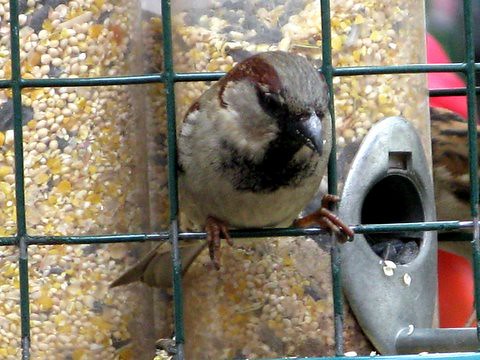
House Sparrows are the bane of many birdwatchers’ existence. Especially in North America, where House Sparrows are an invasive species, these birds are particularly unwelcome. I’ve personally seen House Sparrows drive off Eastern Bluebirds and destroy their eggs. That’s why this issue of getting rid of House Sparrows (AKA “deterring” them) is important to me. In this article, I’m going to give you eight tips for how to get rid of house sparrows from your own yard.
First, let’s talk about what House Sparrows are and why they are a problem.
Photo above by Doug Greenberg is licensed under CC BY-NC 2.0
What Are House Sparrows?
With a population of around 82 million adult birds, House Sparrows are one of the most common song birds in North America. You can find them frequently in urban settings, since they thrive near buildings and around people. Even out in the country, House Sparrows seem to be everywhere – particularly at bird feeders, and near barns and houses.
So what’s wrong with House Sparrows?
Why Are House Sparrows a Problem?
House Sparrows are a cavity-nesting bird that were introduced to North America from the UK in the 1800s under the mistaken notion that they would keep the pest population under control for farmers. It turned out that House Sparrows, who mainly ate grain and seeds instead of insects, were more of a pest than a help for farmers (source).
After their introduction, House Sparrows quickly spread throughout the new continent, since they thrived near human developments. The species’ success eventually became a noticeable problem because, (1) the more aggressive House Sparrows would usually beat-out native cavity-nesting birds, like bluebirds and tree swallows, at nesting sites, and (2) House Sparrows would tend to overtake bird feeders and decrease the diversity of birds in a particular area. Both of these problems are still experienced today.
Even though House Sparrows are here to stay, there are some key ways that you can deter them from your own yard. Here are 8 effective methods of getting rid of House Sparrows.
How to Get Rid of House Sparrows [8 Effective Methods]
1. Place bird houses in open areas, away from houses and barns

Photo by David Cornwell is licensed under CC BY-NC-ND 2.0
If you are trying to get rid of House Sparrows and attract native cavity-nesting birds, one of the bests things you can do is place your bird houses (nest boxes) in open areas. Wide open areas will provide an attractive environment for many native birds, including bluebirds, and they will naturally be less attractive to House Sparrows.
In general, House Sparrows enjoy nesting near houses, barns, and buildings. Because of this, you can frequently see House Sparrows in urban areas as well, since they love to be near humans.
This is where the name House Sparrow comes from actually – they love to be near houses. Probably one of the biggest contributing factors to the spread of the House Sparrow all throughout the globe is their ability to nest so closely to humans.
So, to proactively deter House Sparrows, set up your nest boxes in open areas, away from houses and barns. If you’re trying to attract bluebirds specifically, consider mounting your nest box in one of these spots:
- Near a fence row
- On the edge of an open field
- Facing out over your backyard
- Near a golf course
The next tip is a small change you can make to your bird houses that will make them drastically less attractive to House Sparrows.
2. Remove perches from bird houses

Source: BluebirdLandlord.com
Many small, decorative bird houses come adorned with a perch below the entrance hole. I’ve also seen some larger bluebird houses that contain perches (and I cringe when I see them). A perch seems like it would be a helpful addition to a bird house for any type of bird, but, according to the Michigan Bluebird Society, House Sparrows are particularly attracted to perches (source).
So, to get rid of House Sparrows in your area and to discourage them from using your nest boxes, remove the perches from your bird houses.
It is even better to build or purchase a quality nest box designed specifically for the type of bird you’re trying to attract. If you’re looking to attract bluebirds, you can view my recommended nest boxes on my Recommended Tools page here.
With most cavity nesting birds, like bluebirds, you don’t have to worry about them needing a perch on their nest box. While they might use a perch if it’s available, their feet are designed specifically for clinging to wood, so they have no need for a perch. House Sparrows tend to like them for whatever reason – so ditch the perch to get rid of House Sparrows.
3. Monitor your bird houses regularly to remove House Sparrow nests

Photo by stevesunusual is licensed under CC BY-NC-ND 2.0
House Sparrows are very territorial and persistent at building nests. Once the male sparrow (the one who builds the nest) finds a nesting site that he wants to use, he will usually keep building his nest and intensely defending it from other birds. That’s why one of the best ways to get rid of House Sparrows is to monitor your bird houses regularly to remove House Sparrows nests.
It is in the early stages of building a nest that the male House Sparrow is most likely to move on to a new nesting location if something goes wrong for him. So, if you monitor your nest boxes weekly, you’ll be able to identify House Sparrow nests early and remove them. If you wait until sparrows have built a full nest, with eggs or even with young chicks, the House Sparrows will be harder to get rid of.
Don’t hesitate to remove House Sparrow nests. These birds can build a nest almost anywhere, including gutters and vents, so they don’t need the luxury of your nest box!
Identifying House Sparrow Nests
House Sparrow nests are made of dried grasses, weeds, and other vegetation, and they are generally yellowish-brown in color. Nests might also include some softer items, like feathers, paper, trash, and string in the lining of the nest (source). One key characteristic of House Sparrow nests is that they are stuffed, almost to the top, of the nesting cavity. So, if you find that your nest box is filled to the top with nesting material, it might be a House Sparrow nest.
How to Remove House Sparrow Nests
When you identify a House Sparrow nest, remove all of the nesting material and transfer it into a garbage can or onto the ground in a remote location. Avoid throwing the nest onto the ground near the nest box.
Old sparrow nests tend to attract predators, like cats and raccoons, who might become interested in the nest box if they find it. So, to protect native birds from crawling predators, throw away House Sparrow nests in a remote location away from the nest box when you remove them.
4. Block off crevices in your house’s vents and eaves where House Sparrows may try to nest

Photo by nmahieu is licensed under CC BY-ND 2.0
House Sparrows are very adaptable nesters, and they can build nests in almost any nook or cranny. They particularly love to build nests in eaves, roof corners, gutters, and vents on the sides of houses. If you’re serious about getting rid of House Sparrows, block off these crevices on your house to prevent sparrows from nesting.
If you think you hear sparrows fluttering around in your vents, or you see sparrows flying around a particular spot in your rain gutters, they’re probably trying to build a nest. Look for the nest and remove it just like you would from a nest box.
Once you remove a House Sparrow nest from one of these crevices, you’ll need to block off the area. Doing this will ensure the sparrows don’t return. The Humane Society recommends blocking off these areas with netting, hardware cloth, or other similar materials. Here’s a link to some reasonably priced hardware cloth on Amazon.
Now, let’s talk about one way you can get rid of House Sparrows at your bird feeders.
5. Use high quality bird seed at your feeders to deter House Sparrows

Photo by Barbara L. Hanson is licensed under CC BY 2.0
House Sparrows love to eat cracked corn and millet, grains which many other birds do not care for. Unfortunately, these two grains are common fillers in bags labelled as “mixed bird seed.” Companies add corn and millet to their mixed bird seed to drive down the total cost. To get rid of House Sparrows at your bird feeders, use high quality bird seed that does not include cracked corn or millet.
Foods to offer at your bird feeder (instead of cracked corn and millet):
- Nyger Seeds
- Sunflower Chips/Hearts
- Black Oil Sunflower Seeds
- Chopped Peanuts
- Suet (without seeds)
The foods above will attract all types of native songbirds to your feeder (cardinals, goldfinches, blue jays, woodpeckers, etc.) without unnecessarily attracting House Sparrows.
Eliminating cracked corn and millet from your feeders won’t definitively deter House Sparrows from your yard. But, it will go a long way in reducing sparrows’ available food supply. So, make your bird feeder a haven for native birds and less attractive to sparrows. Cut out the corn and millet!
Here’s a link to the sock-style feeder that I use to attract American Goldfinches. You can fill it with Nyger seed. And here’s the tube-style feeder that I recommend for most other birds. This feeder is perfect for sunflower seeds.
6. Install a “sparrow-spooker” on nest boxes to protect native bird nests

Photo credit: SparrowTraps.net
House Sparrows compete aggressively with native cavity-nesting birds for nest boxes. They also show aggression towards other birds who they view as a threat. It’s not uncommon for House Sparrows to kill young bluebirds or tree swallows in the nest, for no apparent reason other than to assert their dominance. One way to protect native birds from House Sparrows is to install a “sparrow-spooker” on a nest box after the female has begun laying eggs.
A “sparrow-spooker” is a device that you attach to the top of a nest box. It allows shiny, Mylar strips to hang down above the nest box, which effectively “spook” House Sparrows and keep them from entering the box.
When installed correctly, after the native bird has laid her first egg, native birds will feel “attached” to the nest box and they’ll just disregard the sparrow-spooker. So, this really is a genius invention that keeps House Sparrows away, and keeps native birds safe.
Unfortunately, you can’t install a sparrow-spooker until after native birds have laid their first egg. So, it’s not a device that you can just “set and forget.” You’ll need to actively monitor your nest boxes weekly, only putting up the the “sparrow-spooker” once there are eggs or chicks in the box.
Where to Get a Sparrow-Spooker
If you’re a DIY type of person, you can build your own sparrow-spooker. Check out these great sparrow-spooker plans over at the Sialis.org. You can also buy a ready-made sparrow-spooker from SparrowTraps.net with this link here.
Now, let’s get to the most reactive method of getting rid of House Sparrows – trapping.
7. Use an in-box trap to capture individual House Sparrows
If House Sparrows have killed or injured your favorite native birds, like bluebirds or tree swallows, you’ve probably started toying with the idea of trapping and eliminating House Sparrows in your yard. The easiest way to get rid of individual House Sparrows is by trapping them with an in-box trap.
The most common brand of in-box trap is the “Van Ert” trap. This is the style of trap I will be referring to in this section. You can check out Van Ert traps on their website here.
What Is an In-Box Trap?
“Van Ert”-style in-box traps are a simple device that you install on the inside of your nest box. When a sparrow enters, it will trip the trap and the trap will block the entrance hole from the inside. When you notice that the trap has gone off, you can open the nest box and allow the bird to fly into a mesh laundry bag. After confirming that the trapped bird is a House Sparrow, you can quickly eliminate it.
Here is the best video I have found on using an in-box trap for catching House Sparrows.
Get a Van Ert trap on their website here – (link to VanErtTraps.com)
Get a mesh laundry bag here – (link to Amazon)
See the FAQ section below for more information on the legality of trapping and eliminating House Sparrows (FYI, it is legal).
8. Trap multiple House Sparrows with a larger baited trap
If your property seems to be overrun with House Sparrows, you’ll probably need to use more aggressive means of trapping than relying solely on an in-box trap. Larger “baited” sparrow traps are the preferred method for trapping more than one House Sparrow at a time.
Baited traps (also known as “ground,” or “cage” traps) usually look like a cage that you set up on the ground or on a picnic table. You bait the trap with bread, corn, or millet – foods that naturally attract House Sparrows – and when sparrows enter the trap, they are unable to exit. These traps usually work best with a live House Sparrow (a “decoy”) already in the trap, so you will need to keep a source of water and food in this type of trap (source).
There are many types of baited sparrow traps on the market, but the best one is the Deluxe Repeating Sparrow Trap from SparrowTraps.net (click here to see the trap on their website). This model allows you to catch up to 21 House Sparrows in a day, while reducing the number of sparrows that escape the trap. Visit SparrowTraps.net and watch the video below for more info about this specific trap.
Video: The Deluxe Repeating Sparrow Trap from SparrowTraps.net
As you might imagine, trapping and eliminating House Sparrows with this kind of trap is a serious endeavor and you’ll need to do it with a lot of care. You’ll need to provide food and water to “decoy” sparrows and monitor the trap daily to release any native birds that are accidentally caught. As such, make sure you know how to correctly identify House Sparrows and other native songbirds in your area. Get a good field guide (like this Peterson Field Guide from Amazon) to learn how to identify your regional birds.
Since you’re trying to get rid of House Sparrows, there are a few other questions you might be asking. I’ll do my best to answer a few more questions below.
FAQs About Getting Rid of House Sparrows
Is it legal to kill House Sparrows in the USA?
Yes. It is legal to trap and kill House Sparrows in the USA since they are an invasive species that is not federally protected under the Migratory Bird Treaty Act (source: U.S. Fish and Wildlife Service).
Is it legal to kill House Sparrows in Canada?
Yes. It is legal to kill House Sparrows in Canada since they are an invasive species that is not protected under the Migratory Bird Convention Act. However, the same Act does protect House Sparrows within provincial parks and provincial crown game preserves (source: Ontario Field Ornithologists).
Are there any sparrow-proof bluebird houses?
While there are not any truly “sparrow-resistant” bluebird houses or nest boxes, certain nest boxes have a good track record for being less attractive to sparrows. The Gilbertson PVC pipe nest box is one of the best nest boxes to use if you have problems with House Sparrows. Check out the Gilbertson PVC pipe nest box on my Recommended Tools page here.
I also wrote another article specifically on the best types of sparrow-resistant nest boxes. Click here to read that article.
Conclusion: How to Get Rid of House Sparrows
House Sparrows can be quite the nuisance to birdwatchers, especially in North America where they are an invasive species. However, with a little bit of know-how, you can take great steps toward getting rid of these birds from your yard.
I hope these tips are helpful! If you are specifically having problems with House Sparrows using your bluebird nest boxes, check out my article here called How to Keep House Sparrows Out of Bluebird Houses.


